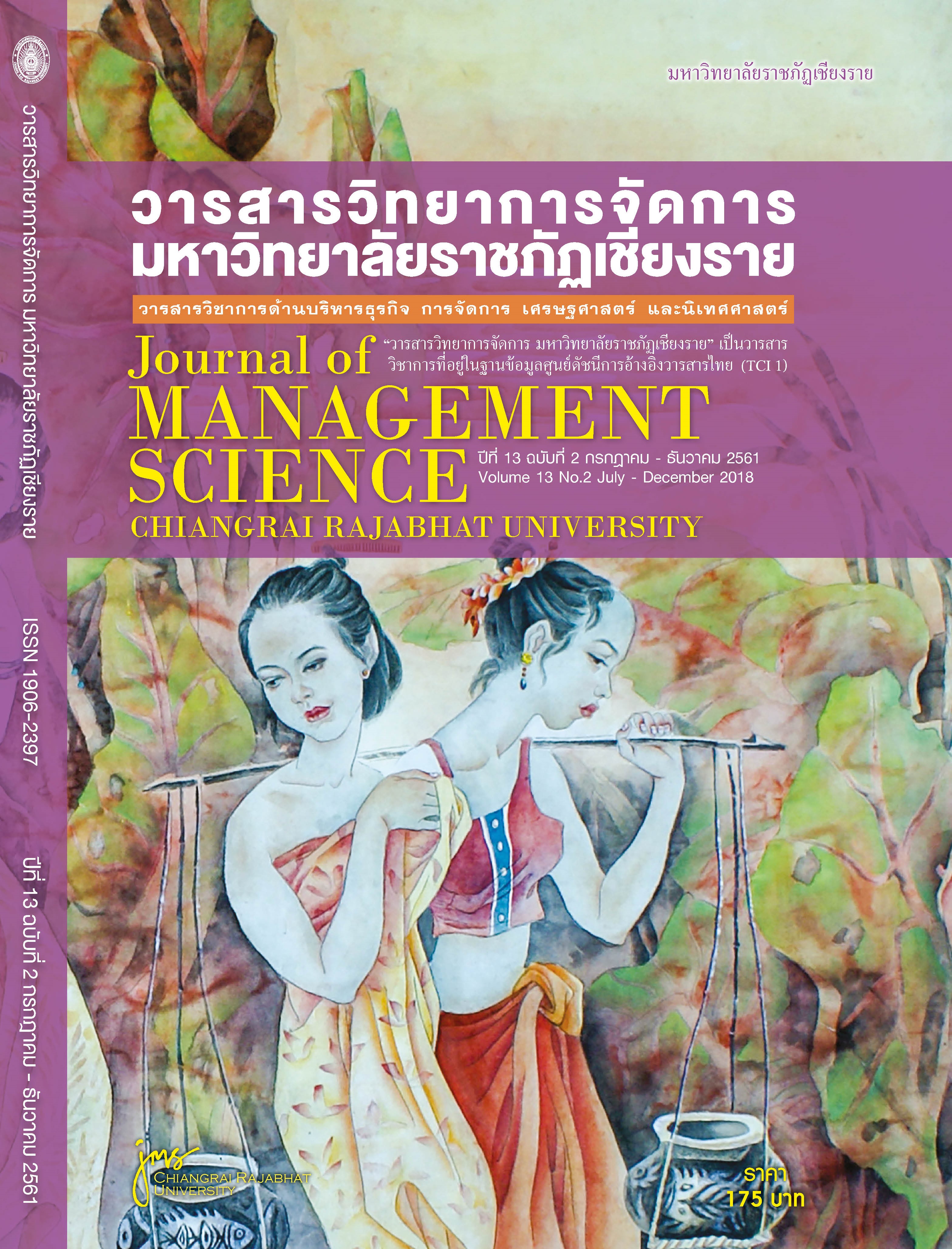Key Success Factors of Thai OTOP
Main Article Content
Abstract
The objective of this research were to study key success factors of Thai OTOP, to analyze the causal confirmatory factors affecting the success of Thai OTOP and to study causal relationship with the structural equation model. The samples using in this study included 355 five stars OTOP entrepreneurs selected by multi stage sampling. The instrument was a questionnaire. Data was analyzed by using computer program in calculating the basic statistics, and confirmatory factor analysis for testing congruence between factor structure model in key success factors of Thai OTOP and the empirical data. The variables as major factors affecting success of Thai OTOP consisted of 5 major variables as follows: 1) the accounting and financial, 2) the production and marketing, 3) the creativity the, 4) entrepreneurship, and 5) the innovation. All of these 5 major factors had to perform through variables with 14 indicators of production and marketing factor, 9 indicators of accounting and financial factors, 2 indicators of creativity factor, 3 indicators of entrepreneurship factor, and 3 indicators of innovation factor. Five major key success factors of Thai OTOP were obtained. There were; 1) the accounting and financial, 2) the production and marketing, 3) the creativity, 4) the entrepreneurship and, 5) the innovation. These five major factors were performed through 31 indicators. The weights loaded of the five factors were 1) 0.557 for the accounting and financial, 2) 0.533 for the production and marketing, 3) 0.202 for the creativity, 4) 0.192 for the innovation, and 5) 0.025 for the entrepreneurship. The goodness of fit of structural relationship model showed its consistency with the empirical data (Chi-Square = 474.372, df = 434, p = 0.088, TLI = .990, CFI = .993, RMSEA = .016, HOELTER = 361). In this research, in was concluded that the statistical analysis results confirmed the research hypotheses.
Article Details
Views and opinions expressed in the journal do not necessarily reflect those of the editors.
References
Aujirapongpan, S. et al,. (2010). Innovation: meaning, types, and importance to entrepreneur. Business Administration journal. 33(128), p49-65.
Basuony, M. A. (2014). The Balanced Scorecard in large firms and SMEs: A critique of the nature, value and application. Accounting and Finance Research, 3(2), 14.
Carraher, S., Auken, H. (2013). The use of financial statements for decision making by small firms. Journal of Small Business & Entrepreneurship Vol. 26 , Iss. 3,2013
Community Development Department, Ministry of Interior. (2015). A Selection of the Top Thailand's One Tambon One Product. Retrieved on August 2015 from https://www.thaitambon.com Hair, et al., (2010). Multivariate data analysis: A global perspective. (7th edition). New Jersey, NJ: Pearson education Inc.
Hana, U. (2013). Competitive Advantage Achievement through Innovation and Knowledge. Journal of Competitiveness, (1), 82-96.
Hiramatsu, M. (1990). Chihou Kara no Hassou [Idea from a Region]. Tokyo: Iwanami Shoten.
Hofstede, G. (2001). Culture’s consequences: Comparing values, behaviours, institutions, and organizations across nations. (2nd ed.). Thousand Oaks: Sage Publications.
Jiasakul, T. (2557). The problems and the adaptation of OTOP to AEC. Exclusive Journal. Vol.34 no.1 (January - June 2557)
Kotler, P. & Keller, K. L. (2006). Marketing Management. New Jersey: Prentice-Hall.
Kurokawa, K. (2009). Effectiveness and limitations of the “One Village One Product” (OVOP) approach as a government-led development policy: Evidence from Thai OTOP. Journal of the Japan Section of the Regional Science Association International, 39(4), 977-989.
Mamabolo, M.A., Kerrin, M. & Kele, T. (2017). Entrepreneurship management skills requirements in an emerging economy: A South African outlook’, Southern African Journal of Entrepreneurship and Small Business Management 9(1), a111.
Nunnally, J. C. (1978). Psychometric theory (2nd ed.). New York: McGraw-Hill.
Okpara, F. O. (2007). The value of creativity and innovation in entrepreneurship. Journal of Asia Entrepreneurship and Sustainability, 3(2), 81–131.
Peetawan, S. (2546). Financial crisis in Thailand and Z-Score Bankruptcy model. University of the Thai Chamber of commerce Journal. Retrieved on August 2015 from https://www.utcc.ac.th/public_content/files/001/P289_1.pdf
Porter, M. E. (1985). Competitive advantage: Creating and sustaining superior performance. New York: Free press.
Ramanust, S. (2014). A Study of Wealth Creation by the Blue Ocean Strategy:The Case Study of OTOP Entrepreneurs in Thailand. Retrieved from https://www.thonburi-u.ac.th/journal/Document/8-15/15-6-Sumali.pdf
Rinrattanakorn, P., Darawong, C. and Chaichinda, C. (2014). Factors Affecting the Success of OTOP Products in Chon Buri Province Research Methodology & Cognitive Science, Vol. 12, No. 2, October 2014– March 2015. P. 35-45
Roth, A. (1992). Success factors in manufacturing. Business Horizons July-August 1992 pp. 73-81 Retrieved from https://www.business.uzh.ch/professorships/som/stu/Teaching/FS10/MA/som/Roth_Miller_1992_strategy.pdf
Seibert, Z., S. E., & Lumpkin, G. T. (2010). The relationship of personality to entrepreneurial intentions and performance: A meta-analytic review. Journal of Management, 36(2), 381-404.
Seubsman, S., Kelly, M. & Sleigh, A. (2013). The Sufficiency Economy and community sustainability in rural northeastern Thailand. Asian Culture and History, 5(2), 57.
Songini, L, Gnan, L & Malmi, T. (2013). The role and impact of accounting in family business. JOURNAL OF FAMILY BUSINESS STRATEGY, Vol. 4, No. 2, pp. 71-83.
Smith, I. & Tubsree, C. (2016). Leadership development in the One Tambon One Product (OTOP) scheme in Thailand. HRD JOURNAL, 7(1), 36-46.


